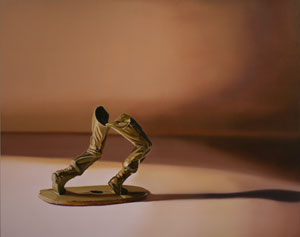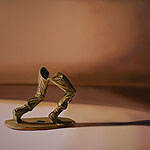John Hartley makes photo-realist paintings of rusted old toys from
photographs of these prettily worn objects, which the artist collects.
In Legs, Hartley has painted a photograph of a corroded pre-WWII lead toy soldier. He intentionally rendered it without exactitude. The figure of the soldier in fatigues stands forth, articulate in a disarticulate space as it floats within a vague ground, its body mottled and anonymous, though it is identifiably that of a toy soldier.
The toy figure in Legs registers in two ways. As an object, it is yesterday’s play pretty, a bauble for a boy who is now a man. As a painting of a toy soldier shown in Imperfections Big and Small at Mighty Fine Arts in Dallas recently, it reads as the mangling of war — the Iraq War. The toys are Hartley’s fetish, and his mimetic documentation of them, the translation of object to photo to painting, reveals our national fetish for war. In painting children’s toy soldiers, Hartley interrogates a society that promotes war as a plaything, as a pastime for children’s recess hour. To set in relief a toy soldier in paint is to query the reasoning behind the inculcation in war at such a young age.
Love of war is completely indoctrinated. We are taught through toys and play, among other things, to be warmongers. There are no born soldiers, only cultivated ones. It only takes an encounter with a mentally damaged vet — a not so unfamiliar occurrence — to understand the irrationality of humans at war. The macabre destruction of war is not natural. We are not supposed to see bodies blown to bits, heads rolling, an arm here, a leg there, or for that matter to experience our own body’s exploding apart. The experience of carnage is not normal. Human beings are not equipped with the psychological machinery — the sense of self formulated in the nerves, the body, the brain — to experience the atrocities of war without detrimental effects.
From object to photograph to painting — it is that space between real object and representation that provides ground for serious analysis. In photographing and then painting the lead soldier, Hartley has created a critical space between dumb object and dumb world wherein the former sets in relief the latter to glaring and gory effect. The act of reproducing here becomes an act yielding a sober and subtle war critique.
A painter and the founder of 414 Gallery in Fort Worth, Hartley has described the evolution from simply painting his loved toys to making images that are quite poignant. While the paintings began, he says, “as a lighthearted figurative study of toy soldiers, deeper meanings became apparent as I completed more paintings. Are they simple representations of children’s toys or are they a commentary on the types of acceptable playthings provided our children?” I would answer that they are both at once. The armless and goggled figurine of Military Venus brings to mind the Venus de Milo, a symbol of Western civilization. At the same time, the painting sets in relief the folly of civilization, referencing the amputated bodies of soldiers who, because of advanced technology, survive war’s carnage in greater numbers than ever before — with minds somewhat intact and bodies less so.
To address Hartley’s question, toys and play are a means by which to indoctrinate children into gender positions. Conspiracy theories aside, little girls play dolly and house, and little boys play cowboys and Indians, and that’s just natural, right? Not altogether. Arguably what Simone de Beauvoir said of women, “One is not born a woman; one becomes one,” holds true for men as well. It’s not just that we become who we are, but we are responsible for whom we become.
If we think literally, the closest parallel to Hartley’s work are the photographs of David Levinthal, in particular Levinthal’s Mein Kampf and Blackface series. With the Mein Kampf images, toys became props in a stage set as Levinthal used toy soldiers, forts and trains to recreate a concentration camp in miniature. Even closer to Hartley’s work, Levinthal’s Blackface series — featuring Aunt Jemima-like and Al Jolson-esque figurines — sets in relief how we have taught, even encouraged, our children racism by manufacturing caricatures of African Americans.
There is a certain degree of heavy-handedness in both Levinthal and Hartley’s work. Hartley, however, has lessened the lumpishness of his paintings by fingering the faultline between abstraction and figuration in his paintings. Sharp Shooter is a blurred close-up in black and gray of a soldier firing his gun. Perhaps less a matter of abstraction and more the raw stuff of matter, the chipped peach-cream paint in Lead Gunner tells us of time past: this soldier was once a glistening white man, standing stalwart with the barrel of his gun projecting from his hip into the viewer’s space.
Hartley’s paintings force us to focus on the theme of “play,” taking it beyond the world of action figures and Toys-R-Us into the realm of art proper. The 1960s seemed like one decade-long recess period for artists. Starting in the late 1950s, Alan Kaprow’s Happenings set the ball rolling for one free-for-all after another of performance and pie-in-the-face immediacy. The Dutch architect Aldo van Eyck designed a bevy of playgrounds for children, injecting their play space with a sure sense of innovative design. The shenanigans of the pan-European art-pranksters the Situationists were not just bald-faced acts of play but theoretical ones as well. [1] They paid homage to the ideas set forth by another Dutchman, Johan Huizinga, who traced the role of play in cultural formation from antiquity to the Middle Ages, from the Sophists to jousting competitions. [2] For Guy Debord and the writers of the journal Internationale Situationniste, play was a means by which to co-opt capitalism. Related to leisure, play was the opposite of moneymaking activity.
Yet all were pipe dreams. The Situationist idea, and ideal, of play is just more bourgeois claptrap from yesterday’s bourgeois avant-garde. Play is at the service of The Man, an idea that is underscored by Hartley’s photo-realist paintings of toys. This is not to say that Hartley’s paintings are any “truer” than the antics of the Situationists back in the day. It is to say that sometimes consciousness-raising happens in more powerful fashion by accident than by intention. And that — the chance discovery of something profound in his work — seems to be another force present in Hartley’s process.
Intention unfortunately has overcome subtlety in Hartley’s latest work. In Spoils of War, the artist moved between replication and unabashed invention, both painting what he saw in a photograph and fabricating what he envisioned in his mind’s eye. It is a painting of a photo of a toy soldier, once again, but in the painting Hartley has added a prosthetic arm. The dynamic between the smooth-edged image of the photograph reproduced as painting and the incisive lines of the artist’s drawn-in prosthetic is like that of well-honed graffiti on an airbrushed surface. The prosthetic arm on the toy soldier is cartoonish in a provocative way.
1. Libero Andreotti, “Play-Tactics of the ‘Internationale Situationniste,’” October 91 (Winter 2000): 36-58.
2. Johan Huizinga, Homo Ludens: A Study of the Play Element in Culture (Boston: The Beacon Press, 1962).
Images courtesy the artist
Charissa N. Terranova is an Associate Professor at SMU and a Contributing Editor to Glasstire.










1 comment
Are we doomed to suffer realist painting, Charissa, since the Situationists were full of pipe dreams?
This sentance is funny. “To set in relief a toy soldier in paint is to query the reasoning behind the inculcation in war at such a young age.” Without toy soldiers boys would just hit each other with sticks. Such inculcation!